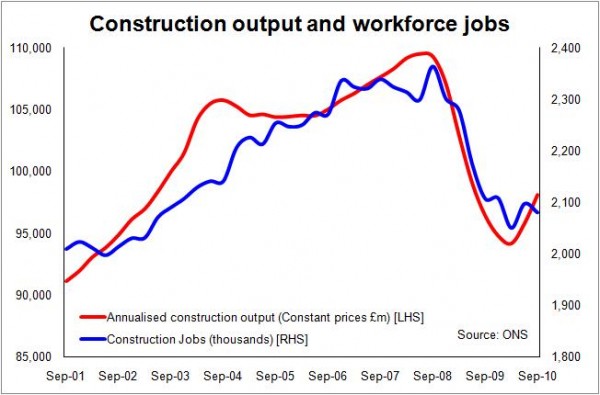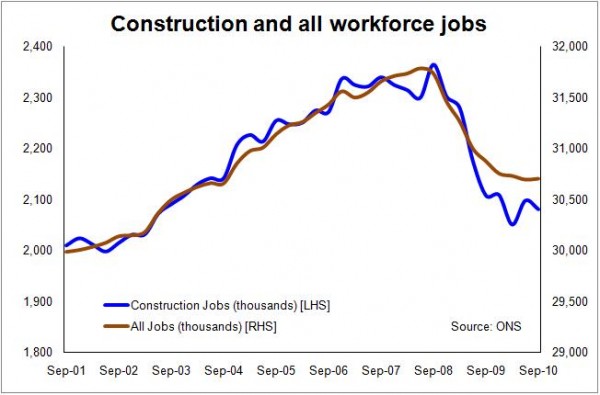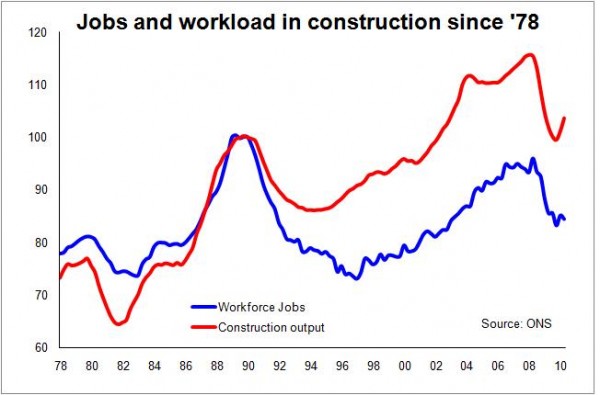Construction firms axe jobs ahead of double-dip downturn
The number of jobs in the construction industry fell by 17,000 in the third quarter of this year despite the continued swell in work resulting from the now fading effects of the economic stimulus.
Indeed the rather lacklustre set of labour market figures released today may well be read by some as an early sign of momentum fading in the economy at large.
 Certainly the drop in construction job numbers will lead many to suspect that firms are already trimming their workforces and holding back on recruitment in expectation of likely drops in workload.
Certainly the drop in construction job numbers will lead many to suspect that firms are already trimming their workforces and holding back on recruitment in expectation of likely drops in workload.
With the impending collapse in public sector work, with orders now falling for about a year and with the first signs in the figures of output slipping back again, this response from firms seems understandable.
If this is the case we should expect to see a significant drop in construction workforce jobs when we see the figures for the final quarter.
In fairness the drop of 17,000 jobs in the third quarter is relatively small given how volatile the construction workforce figures are quarter to quarter. And it should be remembered that the workforce data are not seasonally adjusted, so one should be cautious about reading too much into the figures for one particular quarter.
Meanwhile, there is a mildly encouraging sign in the vacancy figures which suggest there may be a few more jobs in the market for those out of work. However, this may simply be the fact that firms have held off from recruiting for so long that eventually the more successful firms have to start looking to fill gaps in their workforce.
But as we can see from the first graph, the numbers of jobs in the industry has been tracking fairly closely construction output, if we look at it on an annualised (12-month rolling total) basis.
I hasten to add that we have to be a bit cautious with the numbers as both the employment and construction output data should be seen as good estimates rather than actual measured amounts, so they are subject to glitches and inaccuracies.
 When comparing the lot of construction workers compared to the workforce more generally, we see from the second graph that construction workers have so far fared worse than most.
When comparing the lot of construction workers compared to the workforce more generally, we see from the second graph that construction workers have so far fared worse than most.
That said we can assume that without public money pumping into construction this year their plight would have been significantly worse.
However, with forecasters now expecting a further lull in construction work coming through in the next year or so it seems inevitable that there will be a further fall in construction job numbers over the coming few years.
 More worrying is that history suggests that job numbers keep falling well after workload in the industry picks up, as we can see from the final graph, which plots both measures on an index set at 100 for 1990.
More worrying is that history suggests that job numbers keep falling well after workload in the industry picks up, as we can see from the final graph, which plots both measures on an index set at 100 for 1990.
In the 1990s it was two years after the recovery in construction workloads that job numbers began to grow reasonably consistently. The lag in the 1980s was a bit less at about a year, but the recovery was more pronounced.
Looking at the labour market figures more widely they provide concern for the economy as a whole and hence for the construction industry, which is pinning its hopes on a private sector led recovery. There was stagnation in the numbers employed in the private sector.
And the sharp drop in the number of people working full time will concern those in the housing market, as uncertainty over jobs does act as a drag on demand and on people’s willingness to move home.